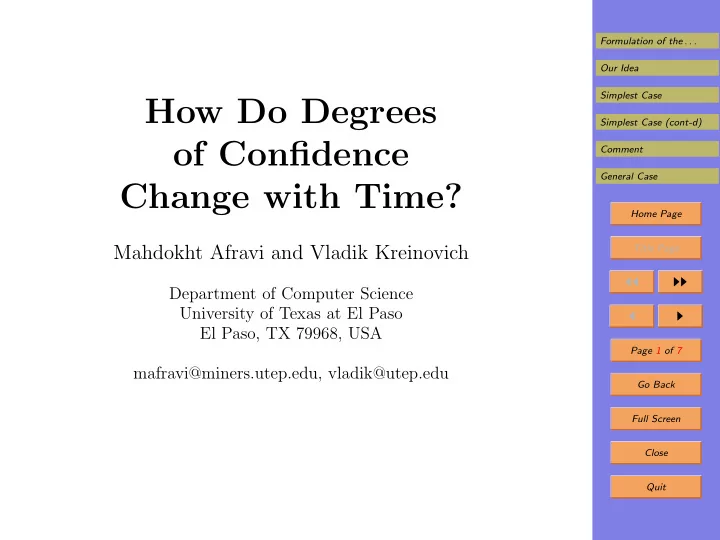

Formulation of the . . . Our Idea Simplest Case How Do Degrees Simplest Case (cont-d) of Confidence Comment General Case Change with Time? Home Page Mahdokht Afravi and Vladik Kreinovich Title Page ◭◭ ◮◮ Department of Computer Science University of Texas at El Paso ◭ ◮ El Paso, TX 79968, USA Page 1 of 7 mafravi@miners.utep.edu, vladik@utep.edu Go Back Full Screen Close Quit
1. Formulation of the Problem Formulation of the . . . Our Idea • Situations change. Simplest Case Simplest Case (cont-d) • As a result, our degrees of confidence in statements based on past experience decrease with time. Comment General Case • How can we describe this decrease? Home Page • If our original degree of confidence was a , what will be Title Page our degree of confidence d t ( a ) after time t ? ◭◭ ◮◮ • (It is clear that d t ( a ) should be increasing in a and decreasing in t , but there are many such functions.) ◭ ◮ Page 2 of 7 Go Back Full Screen Close Quit
2. Our Idea Formulation of the . . . Our Idea • Let f & ( a, b ) be an “and”-operation, i.e., a function that Simplest Case transforms Simplest Case (cont-d) – degrees of confidence a and b in statements A and B Comment – into an estimate for our degree of confidence in General Case A & B . Home Page • There are two ways to estimate our degree of confidence Title Page in the statement A & B after time t : ◭◭ ◮◮ – we can apply the function d t to both a and b , and ◭ ◮ then combine them into f & ( d t ( a ) , d t ( b )), Page 3 of 7 – or we can apply d t directly to f & ( a, b ), resulting in d t ( f & ( a, b )). Go Back • It is reasonable to require that these two expressions Full Screen coincide: Close f & ( d t ( a ) , d t ( b )) = d t ( f & ( a, b )) . Quit
3. Simplest Case Formulation of the . . . Our Idea • If f & ( a, b ) = a · b , then the above equality becomes Simplest Case d t ( a · b ) = d t ( a ) · d t ( b ). Simplest Case (cont-d) • It is known that all monotonic solutions to this equa- Comment tion have the form d t ( a ) = a p ( t ) for some p ( t ). General Case • How to find the dependence on t ? Home Page • Idea: the decrease during time t = t 1 + t 2 can also be Title Page computed in two ways: ◭◭ ◮◮ – directly, as a p ( t 1 + t 2 ) , or ◭ ◮ – by first considering decrease during t 1 Page 4 of 7 ( a → a ′ = a p ( t 1 ) ), and then a decrease during t 2 : Go Back a p ( t 1 ) � p ( t 2 ) a ′ → ( a ′ ) p ( t 2 ) = � = a p ( t 1 ) · p ( t 2 ) . Full Screen • It is reasonable to require that these two expressions Close coincide, i.e., that p ( t 1 + t 2 ) = p ( t 1 ) · p ( t 2 ). Quit
Formulation of the . . . 4. Simplest Case (cont-d) Our Idea • We concluded that Simplest Case Simplest Case (cont-d) p ( t 1 + t 2 ) = p ( t 1 ) · p ( t 2 ) . Comment • The only monotonic solutions to this equation are General Case p ( t ) = exp( α · t ) . Home Page Title Page • So, we get: d t ( p ) = a exp( α · t ) . ◭◭ ◮◮ ◭ ◮ Page 5 of 7 Go Back Full Screen Close Quit
5. Comment Formulation of the . . . Our Idea • We get the formula: Simplest Case d t ( p ) = a exp( α · t ) . Simplest Case (cont-d) Comment • For small t , we get: General Case d t ( p ) ≈ a + α · t · a · ln( a ) . Home Page Title Page • So, the above formula is related to entropy ◭◭ ◮◮ � a i · ln( a i ) . − ◭ ◮ Page 6 of 7 Go Back Full Screen Close Quit
6. General Case Formulation of the . . . Our Idea • It is known that every “and”-operation can be approx- Simplest Case imated, with any accuracy, Simplest Case (cont-d) Comment – by a Archimedean one, General Case – i.e., by an operation of the type Home Page f & ( a.b ) = g − 1 ( g ( a ) · g ( b )) . Title Page • Thus, for re-scaled values a ′ = g ( a ), we have: ◭◭ ◮◮ f & ( a ′ , b ′ ) = a ′ · b ′ . ◭ ◮ Page 7 of 7 • Hence, d t ( a ′ ) = ( a ′ ) exp( α · t ) . Go Back • In the original scale, we have the formula: Full Screen d t ( a ) = g − 1 � ( g ( a )) exp( α · t ) � . Close Quit
Recommend
More recommend